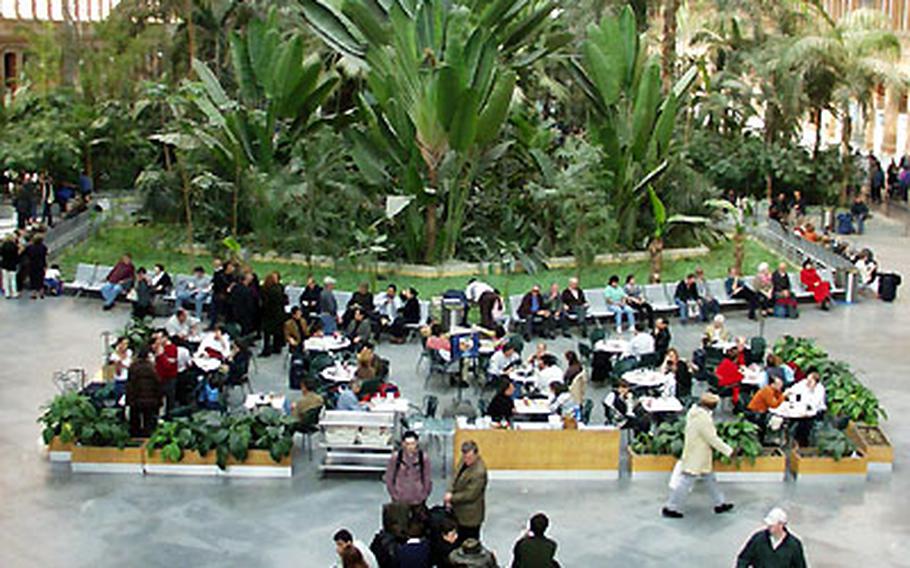
Madrid’s Atoche train station has a botanical garden and restaurant in one section, where travelers can relax before embarking on their trip. (Scott Schonauer / S&S)
Halfway through my beer and ham-and-cheese sandwich, it hit me.We’re going 180 mph! There I am standing in the cafeteria car of Spain’s high-speed train watching olive fields and whitewashed homes flash by me, and I realize how fast we are going.
It’s an incredible sight as I munch on my lunch and sip my brew.
We’re on our way to Madrid from Seville and in two hours and 25 minutes we’ll be there. That is about 1½ hours longer than flying, but more than three hours faster than making the trip by car.
All I could do was thank God I hadn’t chosen one of those forms of transportation.
There aren’t many places in the United States where you can take such a ride by rail, but bullet trains journey between Seville and Madrid daily. There are now 10 trains a day making the 282-mile trip in each direction.
The country’s high-speed trains have quickly become a popular mode of transportation since Spain introduced the routes in 1992.
According to Renfe, the country’s rail service, the high-speed trains are starting to get the upper hand over flying. A survey conducted last year by AVE — which stands for Alta Velocidad Espanola — found that more than 83 percent of the train passengers said they prefer taking the bullet train to flying.
I don’t know exactly why I like taking trains whether it’s at the speed of light or just chugging along. To me, it’s just the better way to go.
It might be the fact that I always have to drive long distances because my wife has the propensity to instantly fall asleep minutes after getting a car, a dangerous scenario if she’s behind the wheel. When we hit the road, I know it is only me and the radio for miles and miles.
I choose to fly only because I have no choice sometimes. Delays and extra security measures only make the experience more dreadful. After the Sept. 11 terror attacks, there’s the added anxiety.
But taking the bullet train?
It has some advantages.
I can stretch my legs, walk to the cafeteria car and have a beer without worrying about any turbulence.
There’s no road rage on a train.
My wife and I took the train on our trip to Toledo. You can buy tickets at any train station but we got ours at a travel agent. Buying them from certified Renfe travel agents help you avoid the lines in the smoky stations. Unfortunately, you cannot get the tickets online.
We took the Andalusia Express train from El Puerto de Santa Maria, the nearest station to Rota. It’s about an hourlong trip from the small, dusty station to Seville’s Santa Justa train station, where we picked up our bullet train to Madrid.
There are two types of high-speed trains in the Spanish fleet.
The AVE S-101 is a 200-meter train with 320 seats categorized into three classes: Club, First Class and Tourist. The train has a maximum speed of 180 mph.
The Talgo 200 is slower and the number of seats varies. It travels about 120 mph.
Inside the AVE, passengers in the economy section sit in chairs similar to what you would find on any airlines.
In all of the cars, there are TVs that show American movies — in Spanish, of course.
The train also includes pay telephones, a cafeteria, family area and nursery. In the Club section, passengers are treated to a catered meal in restaurant-style booths.
The first thing you notice about the train once it starts moving is how smooth the ride is. When the bullet train is cruising along, it hardly feels like you’re moving — even at top speeds. Trees and train stations whiz by in a blur, like some sort of watercolor painting.
If I were to name just one complaint about the journey, it is that it seems as if every passenger had a cell phone and decided to use it. One woman talked from Seville to Cordoba.
There are designated smoking and nonsmoking cars but some passengers smoke between sections, allowing billows of smoke to spread to nearly every part of the train. If you don’t smoke, it’s aggravating.
For the most part, the trains run on time.
The rail system boasts of its punctuality. Brochures say the AVE trains arrive on time 99.5 percent of the time. In Spain, where it is popular to put things off until mañana, that’s a good record.
Our train arrived in Madrid on schedule, giving us plenty of time to catch the train to Toledo.
At Madrid’s Atoche Train Station, there is a section for the bullet trains. The area is only bound to get bigger.
The success of the train has spawned plans to include a route from Madrid to Barcelona. Spain is considering building more than 4,000 miles of high-speed lines in the future. About 780 miles are under construction.
The Barcelona-Madrid line is scheduled to open by the end of next year.
Eventually, high-speed trains will reach every major city in Spain, which sounds good to me.
That means fewer places I have to drive or fly to in the future.